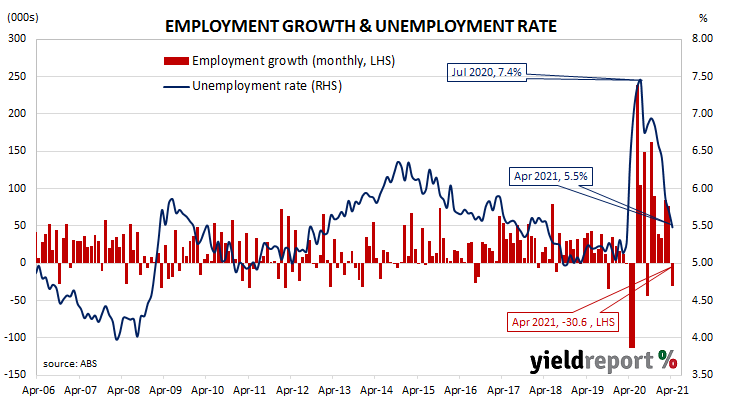Summary: Total employment decreases in April; employment number change less than expected; “softer outcome” a function of Easter; participation rate declines from record high; fewer people seeking work outweighs smaller available workforce, sends jobless rate lower; fewer part-time jobs, more full-time jobs; aggregate work hours fall; underemployment rate falls further below 8%.
Australia’s period of falling unemployment came to an end in early 2019 when the jobless rate hit a low of 4.9%. It then averaged around 5.2% through to March 2020, bouncing around in a range from 5.1% to 5.3%. Leading indicators such as ANZ’s Job Ads survey and NAB’s capacity utilisation estimate suggested the unemployment rate would rise in the June 2020 quarter and it did so, sharply. The jobless rate peaked in July 2020 before falling below 7% a month later. Since then, it has continued to trend lower.
The latest Labour force figures have now been released and they indicate the number of people employed in Australia according to ABS definitions decreased by 30,600 in April. The fall was in contrast to March’s 77,000 increase as well as the generally expected increase of 20,000.
“The softer outcome this month was largely a function of the Easter holiday, which occurred during the survey reference period. As was the case in January, seasonality has distorted the survey and we are unable to ascertain a clear read on the impact of the conclusion of JobKeeper,” said Westpac economist Lochlan Halloway.

Domestic Treasury bond yields eased a touch, ignoring the overnight movements of their US Treasury bond counterparts. By the end of the day, 3-year, 10-year and 20-year ACGB yield had all slipped 1bp each to 0.25%, 1.71% and 2.41% respectively.
In the cash futures market, expectations of a change in the actual cash rate, currently at 0.03%, remained largely unchanged. At the end of the day, contract prices implied the cash rate would gradually rise to around 0.10% by August 2022.
“The decline in employment across April is unlikely to spook policymakers because job losses were expected in some industries after JobKeeper ended in March. And employment gains in the coming months are likely to offset job losses,” said Citi senior economist Faraz Syed.

